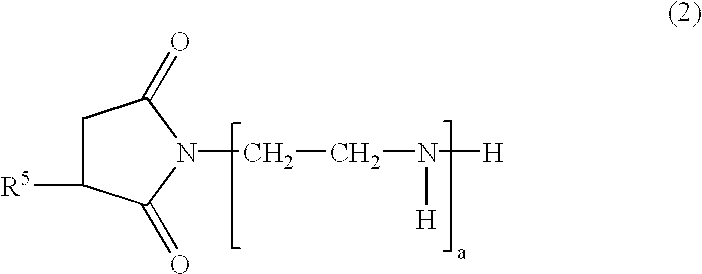Lubricant compositions
a technology of lubricant composition and composition, which is applied in the field of lubricant composition, can solve the problems of increased viscosity of engine oil, engine malfunction, and insufficient sludge inhibiting effect of known polybutenyl succinimides
- Summary
- Abstract
- Description
- Claims
- Application Information
AI Technical Summary
Benefits of technology
Problems solved by technology
Method used
Image
Examples
Embodiment Construction
1 TO 8, AND COMPARATIVE EXAMPLES 1 TO 5
Lubricant compositions of Examples 1 to 8 according to the present invention are prepared in accordance with the formulations indicated in Table 1. Each of the compositions was subjected to the following test for evaluating the properties and the results are also shown in Table 1. Lubricant compositions of Comparative Examples 1 to 5 were also prepared in accordance with the formulations indicated in Table 1. These compositions were also subjected to the same test, and the results are shown in Table 1 as well.
[Test for Evaluating the Ability to Inhibit Sludge Formation]
2.5 g of tetralin and 2 g of dicyclopentadiene were added to 50 g of each lubricant composition. An NOx mixed gas (NO concentration: 5,000 ppm) was blown into the mixture maintained at a temperature of 140.degree. C., at a rate of 160 ml / minute. After 16 hours, the insoluble n-pentane (A method) of each composition was measured in accordance with "Test Method of Insolubles in Use...
PUM
| Property | Measurement | Unit |
|---|---|---|
| kinematic viscosity | aaaaa | aaaaa |
| kinematic viscosity | aaaaa | aaaaa |
| kinematic viscosity | aaaaa | aaaaa |
Abstract
Description
Claims
Application Information
 Login to View More
Login to View More - R&D
- Intellectual Property
- Life Sciences
- Materials
- Tech Scout
- Unparalleled Data Quality
- Higher Quality Content
- 60% Fewer Hallucinations
Browse by: Latest US Patents, China's latest patents, Technical Efficacy Thesaurus, Application Domain, Technology Topic, Popular Technical Reports.
© 2025 PatSnap. All rights reserved.Legal|Privacy policy|Modern Slavery Act Transparency Statement|Sitemap|About US| Contact US: help@patsnap.com



